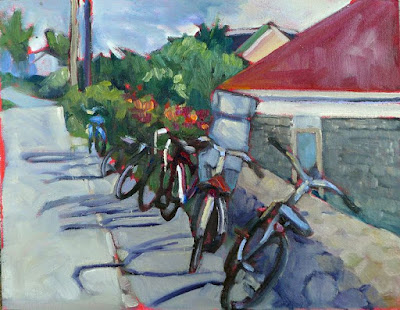You’ve written an amazing post with catchy copy and valuable tips. Now, how do you get discovered?
 |
| Best Buds, by Carol L. Douglas |
Before you start blogging, make sure you have a Facebook business page, separate from your personal page. There are many differences, but the most important is that your business page is always public. It is meant to be a web listing. Spend a little time making sure it’s complete.
This should remain business-like. Keep your political opinions and agit-prop off your business page, unless your art or posts are overtly political. Invite your FB friends to ‘like’ this page; they’re the core of your following.
Also, make sure your email list is up-to-date.
Once your blog post is published, you’ll want to fashion a new ‘hook’, different from the tagline below the headline. You’ll use this and the link every time you repost, as in the illustration above.
| Reading, by Carol L. Douglas, private collection. |
I repost in this order:
- Share photos to Pinterest. This has the longest half-life of any social media site, it’s extremely easy to post to, and it has high viewership.
- Google+. Why add a social media platform that nobody reads? Because what you post on Google+ is indexed on Google.
- Twitter. Remember to manually add a photo to your text and link here.
- Facebook business page. From there, share back to your own personal page, as well as to any user groups in which you’re a member and who might be interested.
There are three other marketing channels for related, but not duplicate, material:
- Google My Business, if you have a brick-and-mortar location.
- Newsletter—I use it only to announce upcoming workshops, 2-6 times a year, but you should definitely use it to introduce your blog to your fans. Ask them to subscribe.
- Instagram—related content, 1-2 times daily.
 |
| Tom Sawyer’s Fence, by Carol L. Douglas |
Why hashtags? Those words are indexed by the social network and are searchable by other readers. If you click on a hashtag, you’ll be brought to a page that aggregates all posts with that tag.
All blog platforms have stats built into them. These tell you how many people are looking at your posts, which posts are the most popular, where your readers come from, and how they’re looking at your blog. Make a habit of looking at it regularly.
Regular readers of this blog know it ran under a newspaper’s aegis for about 18 months. My readership dropped during that time, so I consulted Bob Bahrof Outdoor Painter. He told me that, everything else being equal, it’s always better to work under your own brand rather than someone else’s. My own experience showed that to be true.






